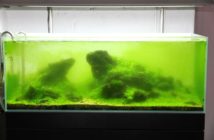The saltwater aquarium hobby, like most hobbies, can be fun and educational. Unlike most hobbies though, this one involves the care of living animals whose well being depends entirely on the skills of the hobbyist. The aquarium hobby requires dedication, along with a lot of research, patience, and funding in order to be a successful venture. Many saltwater aquarium keepers fail to understand a lot of what goes on in the hobby to become successful, and in the process overshoot their budget or kill livestock. After only a year, most new aquarists quit the hobby. To help some new aquarium keepers, AquaNerd has developed this general guide to prevent the big mistakes from being made and help new aquarium keepers enjoy the hobby more.
Research Research Research!!!
Researching saltwater aquariums is the biggest step to becoming successful in this hobby. Saltwater aquariums require quite a bit of knowledge from a variety of different fields, including chemistry, biology, and many others. Since not everybody has a background in biology or chemistry, a lot of personal research is needed. I researched for over a year before I even made my first aquarium purchase, let alone any of the livestock or other equipment. The goal here is to go into it with an advantage, or at the very least the proper tools. So, prepare yourself.
The internet is probably the most readily available resource to most hobbyists, especially beginners. But be careful when researching on the internet. There is a lot of bad information out there, with some of it being rooted in logical thought or even some fact. Despite the fact that this information may be somewhat factual, it is ultimately bad for the hobby. To combat this bad info, realistically think about the information given and ask established hobbyists. More often than not, a seasoned hobbyist will be more than willing to help out a new aquarist. They may even steer you toward a more reliable source. Another possible resource for aquarium knowledge is industry leaders and local fish store employees. The only downside here is the realistic possibility of the individual trying to sell you something that you may not need. So, be weary of that as well.
Take Your Time…
This is one of the biggest mistakes made my new aquarium keepers. They want immediate gratification, and in this hobby it’s just not possible. Simply setting up the aquarium and curing the live rock and sand alone takes more than a month…some people even go to the extremes with that. I’ve heard of people letting their tank cycle for a year! But obviously that is ludicrous. The reason it takes a month or more for the cycle to finish is the fact that biological processes don’t always occur at lightning speed. The dead or dying organisms found on the live rock are releasing ammonia into the water. Ammonia is very bad for aquarium livestock as it will burn gills and is very toxic. After a brief period, the ammonia will spike, or reach its highest concentration. Bacteria present in the sand and rocks are busy converting this ammonia into nitrite…another toxic chemical. Much like ammonia, nitrite levels will spike, then begin to fall. As nitrite levels are falling, nitrate is being produced. Nitrate is non-toxic and will either bubble out as nitrogen gas (provided you have a deep sand bed) or have to be removed via water changes or filtering. If an inexperience aquarists were to as livestock at any point during this cycle, not only would it harm the livestock, but it will also prolong the cycle. So, to avoid making costly mistakes, do not add any livestock to the aquarium until the water tests out to be habitable.
Pick Your Livestock Wisely
A lot of new aquarium keepers do not know how to buy fish, corals, or invertebrates. Sure it sounds easy to do, but there are a million things to look out for before, during, and even after the purchase. For starters, know what you are buying. Don’t buy the cute little fish that your significant other likes. As it turns out, a lot of fish aren’t good pets. They require specific feeding strategies or just don’t eat. The orange-spotted filefish for example only eats the polyps of SPS corals. How are you going to feed that fish if you can’t even keep its food source alive? Don’t buy a big fish, or a fish that will eventually get big, for a small tank…even if you are planning to upgrade down the road or sell the fish. It’s not fair to a tang or triggerfish for example to be housed in a nano aquarium…despite how small it may be in its current state. These fish come from the ocean and swim vast distances every day. They don’t stay in a 12″x12″ area their whole lives. Also, don’t buy livestock you don’t have the appropriate equipment for. Corals and clams need a lot of light since they are photosynthetic. Standard fluorescent lighting simply won’t cut it for most photosynthetic organsims. Long story short, know what livestock you are purchasing. Make a stock list of the fish you would like to house at some point, research them (there’s that word again!!!), and slowly add them to your tank in a well though out order.
I believe that by researching and planning properly, anyone can be successful in this hobby. It’s a very fun, yet expensive hobby that certainly has its rewards. So, take your time and do things right. If you cut corners you’ll end up paying for them down the road unfortunately.





